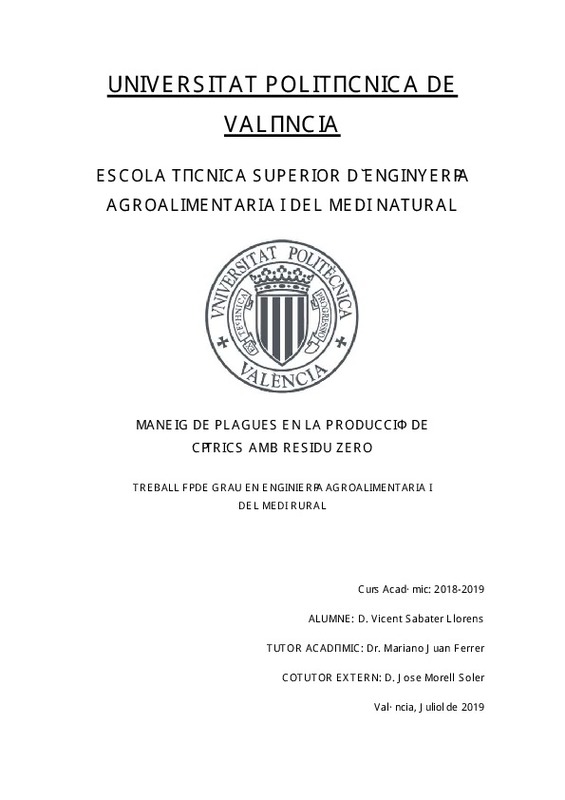|
Resumen:
|
[CA] En l’actualitat, el consumidor de productes hortofructícoles demanda que els aliments
estiguen lliures de residus fitosanitaris. Amb aquesta demanda, hi ha un sorgiment de
nous models de producció basats en l’obtenció ...[+]
[CA] En l’actualitat, el consumidor de productes hortofructícoles demanda que els aliments
estiguen lliures de residus fitosanitaris. Amb aquesta demanda, hi ha un sorgiment de
nous models de producció basats en l’obtenció d’aliments agrosostenibles, com son la
producció integrada i la producció ecològica. No obstant, en els últims anys sorgeix la
producció coneguda com a residu zero (residus de químics per sota de 0,01 ppm).
Aquest model, ja en actiu en alguns cultius, és el que es posà en exercici en aquest
treball, en una explotació comercial de cítrics amb dos cultivars de taronger dolç:
‘Salustiana’ i ‘Navelina’. Per tant, per obtindre la fruita amb residu zero, es treballà amb
el control de plagues per mitjà de mètodes biològics i químics, intentant mantindre un
baix nivell poblacional d’aquelles plagues que resultaven mes transcendentals. Tots els
treballs realitzats perseguiren l’objectiu d’obtindre fruites perquè es pogueren etiquetar
amb el nom de residu zero. Així, per al control del pugó, el tractament amb acetamiprid
(50 ppm) i productes de reforç nutricional, amb poder secant per a la plaga, obtingué
una reducció important de la plaga sense deixar residus químics per dalt de 0,01 ppm
en la fruita recol·lectada. Per al control del cotonet, es recorregué a l’ús del parasitoide
Anagyrus pseudococci i el depredador Cryptolaemus montrouzieri, a més, un
tractament fitosanitari a base de zinc i manganès (40 ppm), conseguint-se reduir la
població, però sense arribar als nivells recomanats, a pesar de no obtindre nivells de
residus per dalt de 0,01 ppm. Per al control del poll roig de Califòrnia, s’optà a l’ús del
parasitoide Aphytis melinus i un tractament a base de spirotetramat (45 ppm) i extractes
vegetals cítrics (135 ppm) o, oli parafínic (4,25 cm3
per litre de caldo) i zinc i manganés
(50 ppm). Obtenint-se nivells de residus químics per damunt de 0,01 ppm de
spirotetramat i un control de la plaga insuficient. Per a la mosca del mediterrani, s’actuà
amb tractaments per pegats a base de spinosad (6,5 ppm), obtenint un bon control de
la plaga i nivells de residus químics compatibles amb la producció de cítrics en residu
zero. No obstant, els objectius plantejats no s’aconseguiren en la seva totalitat, ja que
no es controlà efectivament el cotonet i el poll roig de Califòrnia i, s’obtingueren residus
de químics per damunt de 0,01 ppm en fruita a l’hora de la recol·lecció en aquelles
parcel·les on es tractà amb spirotetramat (45 ppm) i on, en campanyes anteriors,
s’utilitzaren químics amb gran romanència com el fosetil-Al.
[-]
[EN] Nowadays, the horticultural product consumers require free pesticides waste food. About this
petition, there is an emergence of new production models based on to obtain agrosusteinable
aliments, as integrated ...[+]
[EN] Nowadays, the horticultural product consumers require free pesticides waste food. About this
petition, there is an emergence of new production models based on to obtain agrosusteinable
aliments, as integrated production and ecological production. However, in recent years, the
zero residues production has emerged (fruits without chemical or with chemical residues under
0,01ppm). This production model, which is currently functioning in some crops, is the subject
of study in this degree project but focused on citrical exploitation with two varieties of sweet
orange plantation named “Salustiana” and “Navelina”. Therefore, to obtain fruit with zero
residue, it was worked with the control of pests through biological and chemist methods always
trying to keep down the population level of the most far-reaching pests. All the agronomic
actions taken have been done with the aim of obtain labeled fruits with the zero residues
protocol. Thus, for the green citrus aphid control was decided to focus on a treatment with
acetamiprid (50 ppm) and reinforcement nutritional products, with secant power for the plague,
with which was obtained a significant reduction of the pest without leaving chemical residues
above 0,01 ppm in the recollected fruit. For the citrus mealybug control, it was used the
parasitoid Anagyrus pseudococci and the predator Cryptolaemus montrouzieri, adding up a
phytosanitary treatment based on zinc and manganese (40 ppm). This treatment reduced the
population without reaching the recommended levels, despite not obtaining chemical residue
levels above 0,01 ppm. For the California red sacle control, it was used the parasitoid Aphytis
melinus, adding up a treatment based on spirotetramat (45 ppm) and citrus plant extracts (135
ppm), or paraffinic oil (4,25 cm3
) and zinc and manganese (50 ppm). Obtaining phytosanitary
residues above 0,01 ppm and an insufficient pest control. For the Mediterranean fruit fly
control, it was acted through treatments for patches based on spinosad (6,5 ppm), obtaining a
great pest control and compatible chemical residues with the cero residues citrical production.
However, the targets were not achieved because the citrus mealybug and California red sacle
were not effectively controlled and it was obtained residues waste above 0,01 ppm in fruit at
the time of recollection in the plots where it was treated with spirotetramat (45 ppm) and where,
in previous campaigns, chemicals with great permanence such as fosetil-Al were used.
[-]
|







